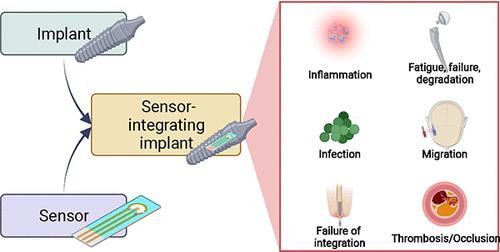当前位置:
X-MOL 学术
›
Chem. Rev.
›
论文详情
Our official English website, www.x-mol.net, welcomes your
feedback! (Note: you will need to create a separate account there.)
Implants with Sensing Capabilities
Chemical Reviews ( IF 51.4 ) Pub Date : 2022-08-18 , DOI: 10.1021/acs.chemrev.2c00005 Mladen Veletić 1, 2 , Ehsanul Hoque Apu 3, 4 , Mitar Simić 5 , Jacob Bergsland 2 , Ilangko Balasingham 1, 2 , Christopher H Contag 3 , Nureddin Ashammakhi 3, 6
Chemical Reviews ( IF 51.4 ) Pub Date : 2022-08-18 , DOI: 10.1021/acs.chemrev.2c00005 Mladen Veletić 1, 2 , Ehsanul Hoque Apu 3, 4 , Mitar Simić 5 , Jacob Bergsland 2 , Ilangko Balasingham 1, 2 , Christopher H Contag 3 , Nureddin Ashammakhi 3, 6
Affiliation

|
Because of the aging human population and increased numbers of surgical procedures being performed, there is a growing number of biomedical devices being implanted each year. Although the benefits of implants are significant, there are risks to having foreign materials in the body that may lead to complications that may remain undetectable until a time at which the damage done becomes irreversible. To address this challenge, advances in implantable sensors may enable early detection of even minor changes in the implants or the surrounding tissues and provide early cues for intervention. Therefore, integrating sensors with implants will enable real-time monitoring and lead to improvements in implant function. Sensor integration has been mostly applied to cardiovascular, neural, and orthopedic implants, and advances in combined implant-sensor devices have been significant, yet there are needs still to be addressed. Sensor-integrating implants are still in their infancy; however, some have already made it to the clinic. With an interdisciplinary approach, these sensor-integrating devices will become more efficient, providing clear paths to clinical translation in the future.
中文翻译:

具有传感功能的植入物
由于人口老龄化和外科手术数量的增加,每年植入的生物医学设备数量都在增加。尽管植入物的好处是巨大的,但体内存在异物可能会导致并发症,这些并发症可能在造成的损害变得不可逆转之前无法检测到。为应对这一挑战,植入式传感器的进步可能有助于及早检测植入物或周围组织的微小变化,并提供早期干预线索。因此,将传感器与植入物集成将实现实时监控并改善植入物功能。传感器集成主要应用于心血管、神经和骨科植入物,联合植入传感器设备取得了显着进展,但仍有一些问题有待解决。传感器集成植入物仍处于起步阶段;但是,有些人已经到了诊所。通过跨学科方法,这些传感器集成设备将变得更加高效,为未来的临床转化提供清晰的路径。
更新日期:2022-08-18
中文翻译:

具有传感功能的植入物
由于人口老龄化和外科手术数量的增加,每年植入的生物医学设备数量都在增加。尽管植入物的好处是巨大的,但体内存在异物可能会导致并发症,这些并发症可能在造成的损害变得不可逆转之前无法检测到。为应对这一挑战,植入式传感器的进步可能有助于及早检测植入物或周围组织的微小变化,并提供早期干预线索。因此,将传感器与植入物集成将实现实时监控并改善植入物功能。传感器集成主要应用于心血管、神经和骨科植入物,联合植入传感器设备取得了显着进展,但仍有一些问题有待解决。传感器集成植入物仍处于起步阶段;但是,有些人已经到了诊所。通过跨学科方法,这些传感器集成设备将变得更加高效,为未来的临床转化提供清晰的路径。









































 京公网安备 11010802027423号
京公网安备 11010802027423号